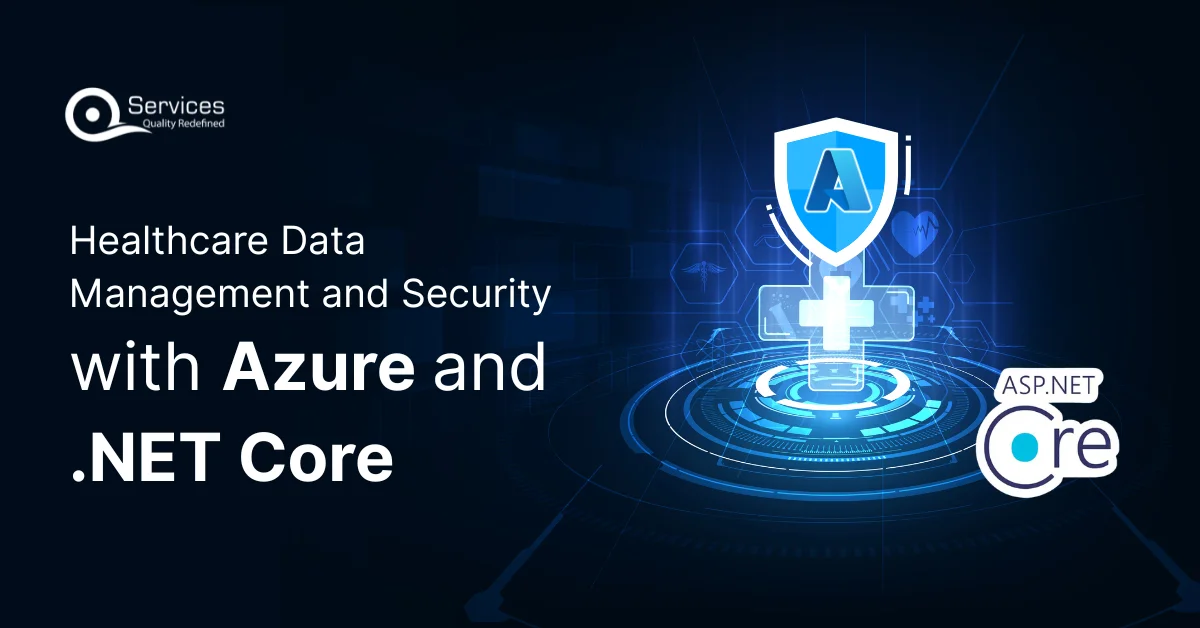
Rewards
.





CANADA
55 Village Center Place, Suite 307 Bldg 4287,
Mississauga ON L4Z 1V9, Canada
Certified Members:
.



Home » Utilizing the Power of Azure Data Science for Your Business

Have you ever wondered how some businesses predict trends and make smarter decisions easily? There’s nothing magical about it; they are simply utilizing their data effectively. Did you know that 80% of global companies are investing in data analytics to stay competitive? With Microsoft Azure’s data science tools, even small to mid-sized companies can unlock valuable insights from their data.
As Peter Sondergaard once said, ‘Information is the oil, and analytics is the combustion engine of the 21st century.’ which means that, just like oil, data needs to be refined and analyzed to be truly valuable. In this blog, we’ll explore how Azure Data Science can transform your business operations, making you more competitive and efficient.
Gone are the days when business decisions relied on intuitions or past experiences. Today, data has taken the lead, giving businesses a solid base for making smarter business choices. By diving into their data, companies can spot trends, get a clearer picture of customer behavior, and even predict what’s coming next. For instance, data-driven organizations are 23 times more likely to acquire customers than companies than those still following traditional methods. This shift toward data-driven decisions helps businesses reduce risks and grab opportunities with confidence.
In today’s digital business world, effective data management is essential. However, many businesses still use traditional methods, leading to significant challenges. Let’s dive into these common problems and understand their impact.
Data silos often occur when information is isolated within different departments or systems, preventing a unified view of the business. This fragmentation can lead to inconsistent data, as different departments may maintain varying versions of the same information. Communication barriers arise, making it difficult for teams to share insights and collaborate effectively, which slows down decision-making processes. Additionally, redundant efforts can occur when multiple teams unknowingly work on the same data, wasting valuable resources and time.
Traditional data management often relies on manual processes that are time-consuming and prone to errors. Slow data processing is a significant issue, as manual data entry and analysis can delay the availability of insights. Human errors are more likely to occur with manual handling, compromising the quality of the data. Furthermore, as data volumes grow, these manual processes become increasingly unsustainable, limiting the business’s ability to scale its data operations efficiently.
Outdated methods can make it challenging to extract meaningful insights from data. Poor data quality, resulting from inaccuracies or incomplete information, can lead to misleading conclusions. Traditional methods may also lack advanced analytical tools, restricting the depth of insights that can be derived. Consequently, businesses may find themselves making reactive decisions based on outdated or incomplete data, rather than proactively addressing issues with real-time insights.
Managing large datasets manually or with outdated systems can be financially burdensome. Manual data management is labor-intensive, requiring significant human resources to maintain. Outdated systems often incur higher maintenance costs and are less efficient compared to modern solutions. Additionally, the opportunity costs associated with inefficient data management can be substantial, as businesses may miss out on potential opportunities due to delayed or inaccurate insights.
Get free Consultation and let us know your project idea to turn into an amazing digital product.

Many businesses deal with fragmented data sources and a lack of expertise in data analysis, making it tough to get valuable insights and make smart decisions. These common issues can lead to inefficiencies and missed opportunities, as data remains underutilized and scattered across different departments.
Introducing Azure data science tools that can simplify this process. With Azure, you can easily integrate data from various sources, giving you a clear, unified view of your business. Azure’s advanced analytics and machine learning capabilities help you analyze data and uncover actionable insights, even if you don’t have a team of data scientists. By leveraging Azure, you can overcome these challenges and unlock the full potential of your data.
Microsoft Azure data science tools, particularly Azure Machine Learning, offer powerful capabilities to help businesses forecast customer behavior, market trends, and operational needs. These tools utilize advanced analytics and machine learning abilities to turn raw data into insights, enabling businesses to make informed decisions.
Azure Machine Learning can help businesses predict customer behavior by identifying patterns and analyzing historical data. For example, e-commerce platforms can use predictive models to recommend products based on past purchases, enhancing the customer experience and boosting sales. Retailers can forecast demand for specific products, ensuring they stock the right items at the right time, reducing inventory costs and increasing customer satisfaction.
Market trend prediction is another area where Azure’s tools shine. By analyzing large amounts of data from various sources, businesses can identify emerging trends and adjust their strategies accordingly. For instance, a fashion retailer can use Azure ML to analyze social media trends and sales data to predict the next big fashion trend, ensuring they stay ahead of the curve. Similarly, financial institutions can forecast market movements and adjust their investment strategies to maximize returns.
Operational needs can also be optimized using Azure’s predictive analytics. Manufacturing companies can predict equipment failures by analyzing sensor data, allowing them to perform maintenance before a breakdown occurs, reducing maintenance costs and downtime. Logistics companies can optimize delivery routes by predicting traffic patterns and weather conditions. These predictive capabilities enable businesses to operate more efficiently and effectively.
Understanding customers is crucial for delivering personalized experiences. Azure Cognitive Services empowers businesses to analyze customer interactions, preferences, and sentiments, allowing them to fine-tune their offerings. By leveraging Azure and AI/ML, these services provide powerful insights into how customers perceive products and services, leading to better engagement and satisfaction.
Azure Cognitive Services uses AI to analyze customer sentiments from various interactions, helping businesses understand how customers feel about their products. This enables personalized recommendations and targeted marketing strategies, enhancing customer engagement.
These advanced capabilities allow businesses to analyze visual content, process speech, and understand natural language. For example, image recognition can help retailers understand which products are most visually appealing to customers, while speech processing can improve customer service interactions.
By integrating these AI insights, businesses can tailor their offerings to meet individual customer needs. This leads to more personalized experiences.
Azure Cognitive Services helps businesses transform customer data into actionable insights, enabling them to create more engaging and personalized customer experiences.

Microsoft Azure offers a free tier includes access to popular services for 12 months, plus $200 in credit for the first 30 days.
You get access to services like Azure Machine Learning, Azure Databricks, and more, which are essential for data science projects.
With the pay-as-you-go model, you only pay for what you use. This is ideal for SMEs as it allows them to scale their usage based on their requirements and budget.
There’s no need for long-term contracts, which means you can adjust your usage and costs as your business grows.
Azure provides tools to help you monitor and manage your spending. You can set budgets and alerts to ensure you stay within your financial limits.
Detailed cost analysis helps you understand where your money is going and how to optimize your spending.
If you have predictable workloads, you can save up to 72% by committing to one- or three-year plans for certain services.
You can exchange or cancel reserved instances if your needs change, providing a balance between savings and flexibility.
Spot instances allow you to take advantage of unused Azure capacity at significant discounts. This is perfect for non-critical workloads that can handle interruptions.
This can be a game-changer for SMEs looking to run large-scale data processing tasks at a fraction of the cost.
If you already have on-premises licenses for Windows Server or SQL Server, you can use them on Azure and save up to 85% on your cloud costs.
This helps you make the most of your existing investments while transitioning to the cloud.
Azure’s scalable infrastructure means that you can start small and expand as per your business requirements, without worrying about capacity constraints.
With data centers around the world, businesses can deploy their applications closer to their customers, improving performance and compliance.
Azure provides powerful tools for AI and machine learning, enabling businesses to gain insights from their data.
Businesses seamlessly integrate data from various sources, including on-premises and other cloud platforms, to create a unified view of your business.
Azure offers robust security features, including encryption, identity management, and threat detection, ensuring your data is protected.
Azure meets a wide range of international and industry-specific compliance standards, helping you meet regulatory requirements.
By leveraging these cost-effective options and scalable pricing models, SMEs can harness the power of Azure Data Science tools to drive innovation and growth without overspending. Whether you’re just starting out or looking to scale, Azure provides the flexibility and tools you need to succeed.
Azure Data Science tools help businesses turn their data into meaningful insights, leading to smarter decisions and long-term growth. By using these tools, companies can uncover new opportunities and stay competitive in today’s data-driven landscape. It’s time to explore Azure Data Science and see how it can transform your business.
For more insights, don’t miss our blog on “How Azure Data Analytics Drives Business Growth?” and discover even more ways to leverage data for success.

Our Articles are a precise collection of research and work done throughout our projects as well as our expert Foresight for the upcoming Changes in the IT Industry. We are a premier software and mobile application development firm, catering specifically to small and medium-sized businesses (SMBs). As a Microsoft Certified company, we offer a suite of services encompassing Software and Mobile Application Development, Microsoft Azure, Dynamics 365 CRM, and Microsoft PowerAutomate. Our team, comprising 90 skilled professionals, is dedicated to driving digital and app innovation, ensuring our clients receive top-tier, tailor-made solutions that align with their unique business needs.

This blog discusses how generative AI can be combined with MongoDB to turn the risk management in finance into an intelligent, streamlined, and scalable practice.

In the healthcare industry, managing and securing sensitive patient data is paramount. With the increasing adoption of cloud technologies, healthcare organizations are leveraging platforms like Microsoft Azure to store, process, and analyse healthcare data. However, with this shift comes the responsibility

The sector that comprises banking, financial services, and insurance (BFSI) is one of the most vulnerable to cyber threats because of massive volumes of sensitive financial and personal data being handled and processed on a daily basis.
Data science has several benefits for businesses such as better decision-making, improved operational efficiency, and better customer insights. By analyzing large datasets, businesses can identify trends and patterns that inform strategic decisions, optimize processes, and predict future outcomes, which leads to cost reduction and productivity increasement.
Azure Data Analytics helps in better decision-making. It provides real-time insights and comprehensive data analysis allowing businesses to process a huge amount of data quickly in an efficient way, turning raw data into actionable insights. Tools like Azure Synapse Analytics and Azure Machine Learning enable organizations to predict trends, identify opportunities, and make data-driven decisions.
To implement Azure Data Science effectively, start with a clear data strategy that matches your business goals. Use templates and standardized processes for consistency and efficiency. Take advantage of Azure’s tools like Azure Machine Learning and Azure Databricks for processing and deploying models. To keep everyone aligned for collaboration between data scientists and business stakeholders. Lastly, handle your projects entirely from data gathering to deployment and monitoring.
Azure Data Science ensures data security and compliance by using robust encryption, strict access controls, and adhering to industry standards like HIPAA and GDPR. Regular audits and compliance certifications help businesses to meet their legal requirements, keeping the data safe and compliant.
When using Azure Data Science tools, businesses usually face three common challenges: data quality issues, integration complexities, and scalability concerns.
To address these, focus on solid data cleaning, use Azure Data Factory for easy integration, and tap into Azure’s scalable infrastructure and tools like Azure Databricks. These are the steps when followed, will surely help your data science projects run smoothly and effectively.
Azure Data Science and Azure Data Analytics serve different purposes. Azure Data Science focuses on building and deploying machine learning models, involving complex data processing and predictive analytics. It’s about creating new insights and predictions from data. Azure Data Analytics, on the other hand, is about analyzing existing data to generate actionable insights and reports helping businesses to understand past performance and make insightful decisions based on historical data.
Integrating Azure Data Science with your current business systems can really enhance your operations. Here’s a quick rundown on how to do it:
By following these steps, you’ll add advanced insights and predictive capabilities to your systems without needing a full overhaul.
Azure Data Science benefits industries like retail (personalized shopping), healthcare (predictive analytics), finance (fraud detection), manufacturing (predictive maintenance), and marketing (targeted campaigns). These sectors see improved efficiency, decision-making, and customer satisfaction.
For measuring the ROI of your Azure Data Science projects, just compare the merits like cost savings and extra revenue with the total costs, which include technology and staff expenses. It helps you to understand the financial impact and value of your data science efforts.
To keep your data quality high in Azure Data Science projects, start with solid data cleaning and validation processes. Use tools like Azure Data Factory for integrating data and Azure Synapse for validating large datasets.
Time-to-time monitoring and updating help to maintain accuracy and consistency. Plus, involving domain experts can really help tackle any data quality issues that arises.
.





55 Village Center Place, Suite 307 Bldg 4287,
Mississauga ON L4Z 1V9, Canada
.




Founder and CEO

Chief Sales Officer

🎉 Thank you for your feedback! We appreciate it. 🙌